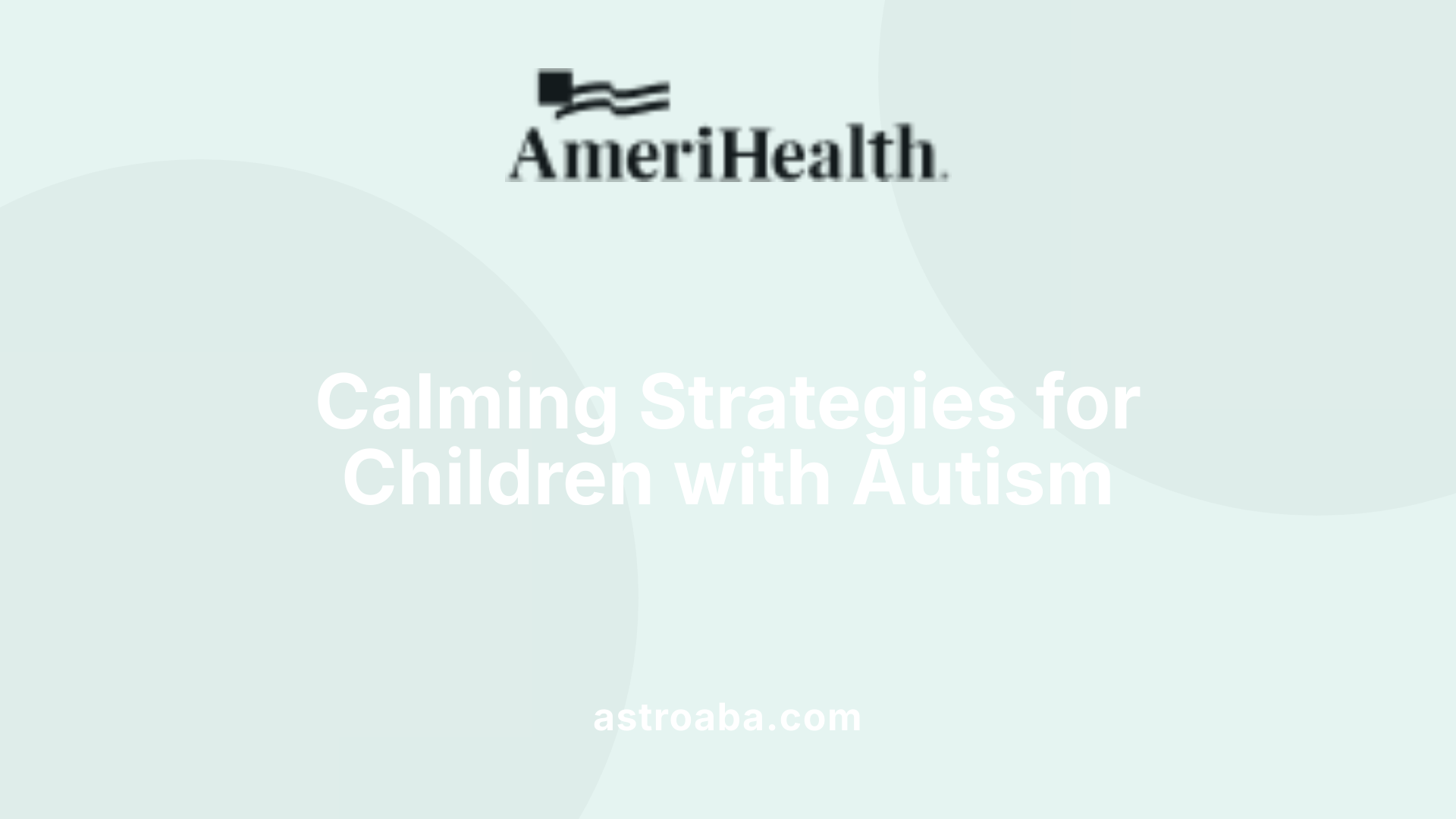Calming Strategies For Kids With Autism
Understanding and Supporting Calmness in Children with Autism

Creating a Calm Environment and Strategies for Autistic Children
Children with autism often experience sensory overload and emotional upheaval that can lead to challenging behaviors. Understanding effective calming strategies and tools is essential for parents, caregivers, educators, and professionals to help these children manage their emotions, reduce anxiety, and navigate overwhelming situations with confidence. This comprehensive guide explores proven techniques, environmental modifications, and proactive practices to foster calmness and emotional regulation in children with autism.
The Nature of Meltdowns and Their Triggers

What is the difference between a meltdown and a tantrum?
Meltdowns are involuntary reactions to nervous system overloads, not deliberate attempts to manipulate or control a situation. They often occur without warning and can last up to 20 minutes or longer. During a meltdown, an individual feels overwhelmed by sensory input or emotional stress, which leads to a loss of control. In contrast, tantrums are learned behaviors performed with a specific goal, like gaining attention or obtaining a desired object or outcome. Tantrums tend to stop once the goal is achieved and are more controlled, driven by the individual's conscious desire rather than an automatic response.
Are meltdowns involuntary responses to nervous system overload?
Yes, meltdowns are involuntary. They happen when the nervous system is unable to process sensory information or emotional cues properly, resulting in automatic, overwhelming reactions. Sensory processing difficulties—such as being overly sensitive to lights, sounds, textures, or smells—can act as triggers for these overloads. When overwhelmed, individuals may become visibly distressed, exhibit behaviors like covering their ears, closing their eyes, or seeking sensory input.
How long do meltdowns typically last, and what are their characteristics?
Meltdowns can last from a few minutes up to twenty minutes or more, depending on the individual and the circumstances. During a meltdown, the person is often overwhelmed, which makes standard calming cues less effective. Signs that a meltdown may be imminent include behaviors like stimming excessively, withdrawing, or seeking sensory input. Recognizing these signs early is crucial for intervention.
Supporting children during stressful situations
Parents and caregivers can play a vital role in supporting children with autism during these times. Creating a calm, predictable environment helps reduce anxiety. Using visual schedules and social stories provides clarity and control, helping children understand what to expect. Maintaining a sense of safety and demonstrating patience through calm communication can prevent escalation. It is also essential to have a plan in place—a safe space or quiet area where children can retreat and self-regulate. Engaging in early intervention programs and developing social and emotional skills can lessen the frequency and intensity of meltdowns. Caregivers should also practice self-care, utilize support networks, and seek professional help if needed. Building a trusting relationship grounded in understanding and acceptance supports children in managing overwhelming feelings more effectively.
Differentiating Meltdowns from Tantrums

How do behavioral differences between meltdowns and tantrums manifest?
Meltdowns and tantrums often look similar but are quite different in their origins and how they present. A meltdown is an involuntary response to nervous system overload, often lasting for 20 minutes or more. During this state, children may seem overwhelmed, withdrawing from their surroundings, covering their ears, or seeking sensory input. It is crucial to understand that during meltdowns, standard behavioral cues like asking a child to stop may be ineffective because the child cannot control or calm themselves through willpower.
In contrast, tantrums are learned behaviors that serve a purpose or goal, such as gaining attention or obtaining a toy. They are often shorter and stop once the child's goal has been achieved. Children typically display aggressive or disruptive behaviors during tantrums, and these can be intentionally controlled or stopped once the goal is met.
What are the goals and functions of tantrums?
Tantrums function as a way for children to communicate their needs or frustrations. They are deliberate behaviors that children learn to express themselves when they lack other effective communication tools. The primary goal of a tantrum might be to secure a toy, get attention, or avoid a demand. Once the child's objective is fulfilled or they feel their request has been acknowledged, the tantrum tends to subside.
How can you tell if a child is experiencing a meltdown or a tantrum?
Recognizing the signs can help caregivers respond appropriately. Signs that a child might be heading into a meltdown include covering their ears, closing their eyes, stimming excessively, seeking sensory input, or withdrawing from the environment. These cues usually indicate sensory overload or overwhelming feelings.
On the other hand, signs of a tantrum include yelling, yelling, throwing objects, hitting, or demanding behavior aimed at getting a specific result. Tantrums often happen in situations where the child has learned to use these behaviors intentionally. They tend to stop when the child's immediate desire is satisfied.
Strategies to support children during overload
Managing meltdowns requires patience and understanding. Providing sensory objects such as slime, fidget toys, textured items, or music can help soothe children during early signs of overload. Creating a calming environment, like a quiet corner with visual schedules and calming tools, offers a safe space for self-regulation.
Importantly, teaching self-calming techniques such as deep breathing, mindfulness, and grounding exercises can help children manage their emotional responses. Visual aids, social stories, and behavior logs are practical tools for helping children recognize triggers and develop coping strategies.
| Behavior Type | Typical Duration | Main Focus | Intervention Approach | Typical Signs |
|---|---|---|---|---|
| Meltdown | Up to 20+ minutes | Overload response | Calm, support, sensory tools, environment adjustment | Covering ears, withdrawal, sensory seeking behaviors |
| Tantrum | Usually minutes | Goal-oriented behavior | Redirection, setting clear limits, teaching communication | Yelling, throwing, demanding, hitting |
Understanding these differences allows caregivers to provide appropriate responses, help children recover more quickly, and reduce the likelihood of escalation or conflict.
Calming Techniques: An Overview

What are effective calming techniques and tools for children with autism?
Children with autism often experience sensory overload that can lead to distressing meltdowns. Implementing calming strategies can significantly help manage these overwhelming moments.
One of the most effective approaches involves using sensory tools and objects. Items like weighted blankets, vests, and lap pads provide gentle, deep pressure that can help regulate the nervous system. Fidget toys such as stress balls, Tangle toys, and squishy balls offer tactile stimulation, channeling restless energy into calming movements.
Noise-canceling headphones are valuable for reducing auditory stimuli, especially in loud, chaotic environments. Sensory bottles filled with glitter, beads, or liquids serve as visual calming devices that redirect focus and promote relaxation. Textured objects, like textured fabrics or sensory sticks, also assist in sensory regulation.
Creating an environment conducive to calmness involves soft lighting, muted colors, and designated quiet spaces. These sensory-friendly areas provide a safe retreat where children can self-regulate when overwhelmed.
Beyond sensory tools, engaging children in calming activities is beneficial. Deep breathing exercises, such as balloon or grounding breathing techniques, teach self-regulation. Yoga routines or gentle stretching can promote body awareness and calm the mind.
Physical activity tailored to the child's preferences, like indoor yoga, outdoor walks, swinging, or bouncing on a trampoline, can help expend excess energy and reduce stress levels.
Establishing consistent routines and visual schedules creates predictability, which fosters a sense of security. Supporting the use of positive reinforcement, like preferred snacks or favorite objects, helps children associate calming routines with positive experiences.
In summary, a combination of sensory tools, calm environment creation, movement, and structured routines can effectively support children with autism in managing sensory overload and preventing meltdowns. These strategies should be personalized according to each child's unique needs and preferences for optimal results.
Environmental Modifications for Support
Creating sensory-friendly environments is essential in helping children with autism manage sensory overload and calm their nervous systems. These spaces are carefully designed to minimize overstimulation and provide comfort through appropriate lighting, textures, and sounds.
Lighting plays a crucial role. Soft, adjustable lighting or dimmable lights create a calm atmosphere, avoiding abrupt brightness that can trigger distress. Textures are also carefully chosen; incorporating tactile objects like soft blankets, textured wall panels, or plush cushions can offer soothing sensory input.
Sound management involves reducing background noise and using calming auditory stimuli. Noise-canceling headphones or white noise machines help block out overwhelming sounds, providing a more controlled auditory environment. Gentle music or nature sounds can foster relaxation.
Providing escape routes and quiet areas enables children to self-regulate when feeling overwhelmed. These designated spaces are equipped with sensory tools such as weighted blankets, fidget toys, and visual schedules, helping children shift away from overstimulating situations safely.
How can caregivers help autistic children transition into calming activities, especially at night or during stressful times?
Caregivers play a vital role in guiding children through transitions. Establishing a predictable routine is fundamental; visual schedules and social stories prepare children for upcoming changes and set expectations. Clear verbal or visual cues can signal when it's time to shift to calming activities.
Incorporating sensory tools like weighted blankets, calming toys, or noise-canceling headphones can help children self-regulate. Engaging in calming activities such as deep breathing exercises, listening to soothing music, or gentle physical movement like stretching or yoga can promote relaxation.
Creating a quiet, consistently comfortable environment with controlled lighting and low noise levels reduces sensory overload during transitions. Patience and positive reinforcement support emotional security, helping children feel safe and independent during these times.
Overall, thoughtful environmental modifications combined with gentle, structured transitions assist children with autism in managing their sensory needs and reducing anxiety.
Recognizing and Responding to Stress and Overload

What are some signs of overload and stress in individuals with autism?
Signs of overload and stress in individuals with autism frequently include behavioral and sensory cues that indicate they are overwhelmed. These can manifest as increased irritability, withdrawal from social interactions, or heightened emotional reactions. Sensory-related behaviors are common during overload and may involve actions like covering ears or eyes to block out overwhelming stimuli, seeking out certain textures or environments, or making loud noises as a way of self-stimulation.
Additional indicators include restlessness, repetitive movements such as rocking or hand flapping, and physical signs like fatigue or discomfort. When a person is nearing a meltdown or shutdown, you might observe them becoming unresponsive, seeking solitude, or showing signs of extreme tiredness. Early in the process, cues like pacing, questioning, or expressing anxiety can signal increasing stress.
Supporting individuals through stress involves creating a calm and sensory-friendly environment. This can include reducing bright lights, loud noises, and sudden movements. Providing a quiet space or sensory tools like fidget toys, weighted blankets, or noise-canceling headphones helps them self-regulate. Recognizing these signs early and responding with patience and understanding can help prevent full-blown meltdowns. It is essential to respect their need for space, allow for sensory breaks, and use calming strategies tailored to their sensory preferences.
Teaching and Reinforcing Self-Soothing Skills
How can children with autism be taught and encouraged to self-soothe?
Supporting children with autism in developing self-soothing abilities involves a combination of sensory-based techniques and visual supports. Children can learn calming strategies such as rocking, humming, or holding their favorite sensory object, which help reduce feelings of overwhelm.
Establishing consistent routines creates predictable environments that make it easier for children to recognize when they might need to use their coping skills. Incorporating sensory-friendly tools like weighted blankets, noise-canceling headphones, and fidget toys into their daily life can prevent sensory overload and promote calmness.
Modeling calming behaviors is also crucial. Caregivers demonstrating deep breathing, mindfulness exercises, or guided imagery provide children with tangible examples of self-regulation methods they can imitate.
Visual supports such as social stories and behavior logs play a significant role.
Social stories explain calming strategies and expected behaviors in clear, relatable language, helping children understand the steps involved during stressful moments.
Behavior logs help track triggers and successful calming responses, enabling tailored intervention plans.
Building this skill set often requires collaboration with professionals, like speech-language pathologists or behavioral therapists, who can offer tailored strategies. Reinforcing positive self-calming actions through praise and encouragement motivates children to practice these skills independently.
Over time, children learn to recognize their emotional cues and apply personalized coping techniques, enhancing their ability to manage emotions and navigate social situations more comfortably.
Supporting Transitions and Handling Meltdowns

How can creating safe spaces during meltdowns help?
Providing a designated calm area or safe space is an effective way to support children experiencing meltdowns. Such spaces, often equipped with sensory tools like soft lighting, weighted blankets, noise-canceling headphones, and calming visuals, offer a retreat where children can self-regulate. When overwhelmed, children benefit from a quiet environment where they can regain control at their own pace, reducing the likelihood of further escalation.
How do visual supports and warning signs aid in managing meltdowns?
Visual supports serve as important tools for early intervention. Visual schedules, social stories, or mood thermometers can help children recognize signs of overload—such as covering ears, seeking sensory input, or withdrawal. Warning signs alert both the child and caregivers that they might be approaching a meltdown. Teaching children to identify these cues encourages proactive management and allows caregivers to implement calming strategies before the situation intensifies.
What are post-meltdown strategies like reassurance and discussion?
Once a child has calmed, offering reassurance helps them feel safe and understood. Engaging in gentle discussions about what happened can validate their feelings and help them develop coping skills. This phase often involves calming routines, deep pressure activities, or calming activities such as coloring or deep breathing exercises. Over time, consistent support during this recovery period encourages emotional resilience and better self-regulation.
Targeted strategies for calming autistic children during meltdowns or tantrums
Targeted techniques include creating a safe, quiet environment and giving children physical and emotional space to regain control. Caregivers should remain calm, modeled through patient and soothing behavior. Sensory aids like noise-canceling headphones or tactile objects, along with breathing exercises and preferred calming activities such as squeezing a stress ball, can support regulation. Visual signs and social stories help children understand their feelings early, enabling quicker intervention.
Post-meltdown, offering reassurance, maintaining a calming routine, and talking through the event affirms the child's feelings and builds their coping repertoire. Regularly practicing these strategies when the child is calm prepares them to utilize them during distress, fostering independence in self-regulation.
Visual aid: Summary of calm and support strategies
| Strategy | Description | Benefits |
|---|---|---|
| Safe/Quiet Space | Dedicated calming environment with sensory tools | Self-regulation, reduces escalation |
| Visual Supports | Schedules, social stories, warning signs | Early recognition, communication aid |
| Sensory Aids | Noise-canceling headphones, tactile objects, weighted blankets | Minimize overload, promote calmness |
| Breathing and Relaxation | Deep breathing, mindfulness exercises | Emotional regulation, tension release |
| Post-meltdown Routine | Reassurance, discussion, calming activities | Emotional healing, skill building |
Using these approaches tailored to each child's needs fosters a supportive environment that promotes self-awareness, emotional safety, and the development of effective coping strategies during challenging moments.
Fostering Confidence and Independence in Calming Practices
Supporting children with autism in developing effective calming strategies is a vital part of fostering their emotional resilience and independence. By understanding their unique sensory needs, recognizing early signs of overload, and implementing a variety of calming tools and techniques, caregivers can create a safe environment that promotes self-regulation. Teaching children self-soothing methods, maintaining consistent routines, and establishing sensory-friendly spaces empower children to manage their emotions proactively. With patience, understanding, and professional support, children with autism can learn to navigate overwhelming situations more smoothly, building confidence and independence in their ability to calm and cope as they grow.
References
- Meltdowns & Calming Techniques in Autism
- 7 Calming Strategies for Autism Every Parent or Guardian Should ...
- 10 Calming Strategies for Autism: Reduce Anxiety and Meltdowns
- Calming Strategies - Sesame Workshop
- 7 Calming Strategies for Autism - Experia USA
- 10 Tips on How to Calm an Autistic Child - Autism Parenting Magazine
- Calming Strategies to Support an Autistic Person - Autism Awareness
Recent articles

The Role of Prompting and Fading in ABA Therapy Programs
Enhancing Autism Interventions Through Systematic Support Reduction

The Role of ABA Therapy in Supporting Community Participation
Enhancing Lives Through Community-Focused ABA Interventions

The Role of ABA Therapy in Encouraging Initiative and Motivation
Unlocking Potential: How ABA Empowers Children to Take Initiative

How ABA Therapy Helps Children Develop Initiation and Motivation
Unlocking Potential: The Power of ABA in Fostering Child Independence

How ABA Therapy Encourages Participation in Cooperative Group Activities
Fostering Social Skills Through ABA Interventions

How ABA Therapy Supports Independent Task Initiation in Children
Empowering Children to Begin with Confidence

How ABA Therapy Helps Children Build Resilience in Challenging Situations
Building Emotional Strength Through ABA Therapy

The Impact of ABA Therapy on Reducing Anxiety in Social Settings
Transforming Social Experiences: How ABA Therapy Eases Autism-Related Anxiety

Strategies for Teaching Self-Monitoring Through ABA
Empowering Independence: Techniques to Foster Self-Monitoring with ABA

The Benefits of Combining ABA with Speech and Language Therapy
Integrating Treatment Approaches to Maximize Developmental Progress

Strategies for Teaching Cooperative Problem-Solving Through ABA
Enhancing Collaborative Skills with ABA: Proven Strategies and Techniques

How ABA Therapy Encourages Independent Participation in Daily Tasks
Empowering Autonomy: How ABA Therapy Builds Independence in Daily Life

Creating an Effective Learning Environment at Home for ABA Therapy
Building a Supportive Home Environment for ABA Success

How ABA Therapy Encourages Following Safety Rules at Home and School
Empowering Children with Autism to Follow Essential Safety Rules

How ABA Therapy Encourages Communication Using Gestures and Signs
Enhancing Social Skills with Targeted Gesture Teaching

Common ABA Therapy Techniques for Reducing Aggression
Innovative Strategies in ABA to Minimize Aggressive Behaviors

How ABA Therapy Encourages Communication Using Gestures and Signs
Unlocking the Power of Gestures and Signs in Autism Therapy

How ABA Therapy Encourages Appropriate Social Greetings
Enhancing Social Skills Through Evidence-Based Interventions

Addressing Social Anxiety Using ABA-Based Techniques
Harnessing ABA to Alleviate Social Anxiety

Famous Politicians With Autism
Celebrating Neurodiversity: Insights into Autism and Notable Figures

How ABA Therapy Can Help with Anxiety in Children with Autism
Unlocking Emotional Well-Being: The Power of ABA in Managing Autism-Related Anxiety

The Impact of ABA Therapy on School Success
Enhancing Educational Outcomes with Systematic Interventions

The Importance of Social Stories in ABA Therapy
Harnessing Social Stories to Enhance Social Skills in Autism Interventions

Mild Autism
Understanding the Nuances of Mild Autism

What Are Functional Behavior Assessments (FBA) in ABA Therapy?
Unlocking the Secrets Behind Behavior: The Power of FBAs in ABA

Early Signs Of Autism In Babies And Kids
Recognizing Early Indicators to Support Developmental Health

How to Find Funding for ABA Therapy Services
Unlocking Funding Opportunities for Autism Treatments

How to Help a Child with Autism Transition to ABA Therapy
Supporting Children Through Transition Phases in ABA Therapy

Do Autistic People Get Injured More?
Examining Injury Risks in Individuals with Autism Spectrum Disorder

How ABA Therapy Can Help with Executive Functioning Challenges
Unlocking Skills: The Impact of ABA on Executive Functioning in Autism

What is the Premack Principle in ABA Therapy?
Unlocking Motivation: The Power of the Premack Principle in ABA Therapy

Low-Functioning Autism
Understanding the Challenges and Supports for Low-Functioning Autism

Low-Functioning Autism
Understanding the Challenges and Supports for Low-Functioning Autism

How ABA Therapy Can Help with Playdates and Social Events
Unlocking Social Success: How ABA Therapy Facilitates Playdates and Community Engagement

How ABA Therapy Can Address Impulse Control Issues
Mastering Behavioral Growth: The Power of ABA in Impulse Control

Book, Movie, and TV Characters on the Autism Spectrum
Enhancing Understanding Through Fictional Portrayals

Book, Movie, and TV Characters on the Autism Spectrum
Enhancing Understanding Through Fictional Portrayals

The Role of Visual Supports in ABA Therapy
Enhancing Autism Interventions with Visual Supports

What Is Pervasive Developmental Disorder
Understanding the Spectrum of Developmental Challenges

How ABA Therapy Helps with Emotional Regulation
Empowering Emotional Resilience in Children with Autism

What is Task Analysis in ABA Therapy?
Unveiling the Foundations of Task Analysis in ABA Therapy

How ABA Therapy Can Improve Play Skills
Unlocking Growth: The Power of ABA in Enhancing Play Skills

Air Pollution and Autism
Unveiling the Environmental Impact on Developing Minds

How ABA Therapy Can Help with Bullying Prevention
Building Respect and Resilience Through ABA

How ABA Therapy Can Be Used to Teach Problem-Solving Strategies
Empowering Individuals with Autism Through Targeted Problem-Solving Skills

Can Autistic People Work?
Unlocking Potential: The Realities of Employment for Autistic Individuals

How ABA Therapy Can Help with Homework and Academics
Empowering Academic Success with ABA Therapy

Common Myths About ABA Therapy Debunked
Unmasking Autism Treatment: The Truth About ABA Therapy

Does Aluminum Cause Autism?
Unraveling the Link: Aluminum and Autism Spectrum Disorder

How ABA Therapy Can Support Emotional Expression and Understanding
Unlocking Emotional Growth in Autism Through ABA Therapy

The Role of ABA Therapy in Helping Children Learn Road Safety
Empowering Safe Journeys: How ABA Therapy Fosters Road Safety Skills in Children

The Role of Group ABA Therapy in Social Development
Enhancing Social Skills Through Collective Strategies

What Is Autistic Burnout?
Understanding the Hidden Struggle of Autistic Burnout

How Do You Get An Autistic Child To Keep Their Shoes On?
Mastering Comfort and Compliance with Shoes for Autistic Children

The Role of ABA Therapy in Addressing Food Aversions and Picky Eating
Transforming Mealtimes: How ABA Therapy Supports Children with Autism

How ABA Therapy Can Assist in Reducing Perfectionism and Anxiety
Harnessing Behavioral Science to Ease Perfectionism and Anxiety

What Is Defeat Autism Now?
Unveiling the Roots and Realities of the DAN Movement

How ABA Therapy Can Help Children Develop Conflict Resolution Skills
Building Bridges: Empowering Children with Conflict Resolution Skills through ABA

OCD vs. Autism
Unraveling the Complex Relationship Between OCD and Autism

Temper Tantrums A Sign Of Autism
Understanding the Complex Relationship Between Temper Tantrums and Autism Spectrum Disorder

How to Pass the BCBA Exam
Your Ultimate Guide to Success in the BCBA Exam

Autism and Addiction's Close Connection
Unraveling the Complex Interplay Between Autism and Substance Use

Autism Facial Expressions
Decoding Emotions: The Complex World of Facial Expressions in Autism

How ABA Therapy Can Help Reduce Anxiety Around Doctor and Dentist Visits
Transforming Medical Experiences for Children with Autism

How ABA Therapy Can Help with Navigating Social Media Responsibly
Empowering Safe Online Engagement for Children with Autism through ABA

How to Choose an Autism Charity
Navigating the Spectrum of Support: A Guide to Selecting the Right Autism Charity

What is Precision Teaching in ABA Therapy?
Harnessing Data-Driven Strategies for Skill Mastery

Autism and Obesity
Understanding the Overlap: Autism and the Rising Concern of Obesity

Individualized Education Programs (IEPs) for Autism
Supporting Success: A Comprehensive Guide to IEPs for Children with Autism

How to Integrate ABA Therapy into Everyday Routines
Transforming Daily Life with ABA Strategies

What is Shaping in ABA Therapy?
Understanding the Core of Behavior Shaping in Autism Interventions

Autism vs. ADHD
Understanding the Distinction and Overlap of Neurodevelopmental Disorders

Is RBT Certification Worth It?
Unveiling the Value of RBT Certification in the Field of ABA

How Negative Reinforcement Works in ABA Therapy
Unlocking the Power of Negative Reinforcement in Behavioral Therapy

How to Advocate for ABA Therapy Services in Schools
Navigating Advocacy for School-Based ABA Therapy

How ABA Therapy Can Address Impulsivity in Children
Transforming Child Behavior: The Power of ABA Therapy Against Impulsivity

Understanding the Different Types of ABA Therapy Programs
Exploring the Spectrum of ABA Therapy Approaches

How ABA Therapy Can Address Regression in Autism
Understanding Regressive Autism and the Role of ABA Therapy

High Functioning Autism And Anger
Understanding Emotional Challenges in High-Functioning Autism

Autism and Puberty
Understanding Puberty in Autistic Youth: Challenges and Support Strategies

Challenging Autism Behavior Problems
Navigating the Complex Landscape of Autism-Related Behavioral Challenges

How ABA Therapy Can Help with Sleep Problems
Transforming Bedtime Routines with Evidence-Based Approaches

How ABA Therapy Can Help Improve Cooperation and Compliance
Fostering Respectful Engagement: The Role of ABA in Enhancing Cooperation and Compliance

Eating Disorders And Autism
Unraveling the Complex Relationship Between Autism and Eating Disorders

How Schedules of Reinforcement Work in ABA Therapy
Mastering Reinforcement Patterns to Foster Behavior Change

How to Incorporate ABA Therapy into a Homeschooling Program
Transforming Homeschooling with Evidence-Based Strategies

What Are the Most Common Misconceptions About ABA Therapy?
Unveiling the Truth Behind ABA Therapy: Myths vs. Facts

What is Demand Fading in ABA Therapy?
Demystifying Demand Fading in ABA Therapy

What Are ABA Assessments and How Do They Work?
Understanding the Foundations of ABA Assessments

What is an AAC Device for Autism?
Unlocking Communication: The Power of AAC Devices for Autism

How ABA Therapy Can Help Children Understand and Express Emotions
Enhancing Emotional Understanding Through Evidence-Based Interventions

How To Prevent Autism
Emerging Strategies to Reduce Autism Risk in Children

How ABA Therapy Can Improve Verbal and Nonverbal Communication
Unlocking Communication: The Power of ABA Therapy for Children with Autism

Natural Environment Teaching (NET): How It Helps with Skill Generalization
Unlocking Practical Learning in Natural Settings

What Is Play Therapy For Autism?
Unlocking the Potential of Play in Autism Therapy

How ABA Therapy Can Improve Fine and Gross Motor Skills
Enhancing Movement and Independence Through ABA Strategies

Calming Strategies For Kids With Autism
Understanding and Supporting Calmness in Children with Autism

Autism Evaluation
Comprehensive Insights into Autism Assessment and Diagnosis

How to Support Your Child's ABA Therapy at Home
Empowering Your Child’s Development at Home with ABA Support

Autism Prevalence Increases in Arizona
Rising Autism Rates Signal Changing Landscape in Arizona

